In Silico Investigation of AKT2 Gene and Protein Abnormalities Reveals Potential Association with Insulin Resistance and Type 2 Diabetes
Abstract
1. Introduction
2. Materials and Methods
2.1. Dataset Download
2.2. Predicting the Effects of nsSNPs on AKT2 Protein Function
2.3. The Prediction of Associations between nsSNPs and Disease
2.4. Predicting the Impact of SNPs on Protein Stability
2.5. Prediction of SNP Pathogencicty and Function Alteration on AKT2 Protein Using Mut-Pred Server
Analyzing Protein Sequence Conservation Using ConSurf Server
2.6. Determination of the Active Binding Site Using PyMol Software
2.7. Performing Molecular Dynamics Simulations (MDS)
3. Results
3.1. The Anticipation of the Characteristics of SNPs
3.2. Identifying Disease-Linked SNPs
3.3. The Prognostication of the Impact of Protein Stability
3.4. Prediction of the Pathogenicity and Underlying Functional Alterations of nsSNP Effects on AKT2 Protein
3.5. Study of Sequence Conservation
3.6. Molecular Dynamics Simulation
3.6.1. Temperature, Pressure and Density
3.6.2. Root-Mean-Square Deviation (RMSD) and Root-Mean-Square-Fluctuation (RMSF)
3.6.3. Radius of Gyration (Rg) and Solvent Accessibility Surface Area (SASA)
4. Discussion
5. Conclusions
Author Contributions
Funding
Institutional Review Board Statement
Data Availability Statement
Conflicts of Interest
References
- Roep, B.O.; Thomaidou, S.; van Tienhoven, R.; Zaldumbide, A. Type 1 diabetes mellitus as a disease of the beta-cell (do not blame the immune system?). Nat. Rev. Endocrinol. 2021, 17, 150–161. [Google Scholar] [CrossRef] [PubMed]
- Wysham, C.; Shubrook, J. Beta-cell failure in type 2 diabetes: Mechanisms, markers, and clinical implications. Postgrad. Med. 2020, 132, 676–686. [Google Scholar] [CrossRef] [PubMed]
- McIntyre, H.D.; Catalano, P.; Zhang, C.; Desoye, G.; Mathiesen, E.R.; Damm, P. Gestational diabetes mellitus. Nat. Rev. Dis. Primers 2019, 5, 47. [Google Scholar] [CrossRef]
- Banday, M.Z.; Sameer, A.S.; Nissar, S. Pathophysiology of diabetes: An overview. Avicenna J. Med. 2020, 10, 174–188. [Google Scholar] [CrossRef] [PubMed]
- Kolb, H.; Martin, S. Environmental/lifestyle factors in the pathogenesis and prevention of type 2 diabetes. BMC Med. 2017, 15, 131. [Google Scholar] [CrossRef] [PubMed]
- Alzahrani, O.R.; Alatwi, H.E.; Alharbi, A.A.; Alessa, A.H.; Al-Amer, O.M.; Alanazi, A.F.R.; Shams, A.M.; Alomari, E.; Naser, A.Y.; Alzahrani, F.A.; et al. Identification and Characterization of Novel Mutations in Chronic Kidney Disease (CKD) and Autosomal Dominant Polycystic Kidney Disease (ADPKD) in Saudi Subjects by Whole-Exome Sequencing. Medicina 2022, 58, 1657. [Google Scholar] [CrossRef]
- Elfaki, I.; Mir, R.; Abu-Duhier, F.M.; Khan, R.; Sakran, M. Phosphatidylinositol 3-kinase Glu545Lys and His1047Tyr Mutations are not Associated with T2D. Curr. Diabetes Rev. 2020, 16, 881–888. [Google Scholar] [CrossRef] [PubMed]
- Elfaki, I.; Mir, R.; Duhier, F.M.A.; Alotaibi, M.A.; Alalawy, A.I.; Barnawi, J.; Babakr, A.T.; Mir, M.M.; Altayeb, F.; Mirghani, H.; et al. Clinical Implications of MiR128, Angiotensin I Converting Enzyme and Vascular Endothelial Growth Factor Gene Abnormalities and Their Association with T2D. Curr. Issues Mol. Biol. 2021, 43, 1859–1875. [Google Scholar] [CrossRef]
- Jha, C.K.; Mir, R.; Elfaki, I.; Javid, J.; Babakr, A.T.; Banu, S.; Chahal, S.M.S. Evaluation of the Association of Omentin 1 rs2274907 A > T and rs2274908 G > A Gene Polymorphisms with Coronary Artery Disease in Indian Population: A Case Control Study. J. Pers. Med. 2019, 9, 30. [Google Scholar] [CrossRef] [PubMed]
- Mir, R.; Elfaki, I.; Javid, J.; Barnawi, J.; Altayar, M.A.; Albalawi, S.O.; Jalal, M.M.; Tayeb, F.J.; Yousif, A.; Ullah, M.F.; et al. Genetic Determinants of Cardiovascular Disease: The Endothelial Nitric Oxide Synthase 3 (eNOS3), Kruppel-Like Factor-14 (KLF-14), Methylenetetrahydrofolate Reductase (MTHFR), MiRNAs27a and Their Association with the Predisposition and Susceptibility to Coronary Artery Disease. Life 2022, 12, 1905. [Google Scholar] [PubMed]
- Cai, L.; Wheeler, E.; Kerrison, N.D.; Luan, J.; Deloukas, P.; Franks, P.W.; Amiano, P.; Ardanaz, E.; Bonet, C.; Fagherazzi, G.; et al. Genome-wide association analysis of type 2 diabetes in the EPIC-InterAct study. Sci. Data 2020, 7, 393. [Google Scholar] [CrossRef] [PubMed]
- Pei, J.; Wang, B.; Wang, D. Current Studies on Molecular Mechanisms of Insulin Resistance. J. Diabetes Res. 2022, 2022, 1863429. [Google Scholar] [CrossRef] [PubMed]
- Batista, T.M.; Haider, N.; Kahn, C.R. Correction to: Defining the underlying defect in insulin action in type 2 diabetes. Diabetologia 2022, 65, 1064. [Google Scholar] [CrossRef] [PubMed]
- Chu, N.; Viennet, T.; Bae, H.; Salguero, A.; Boeszoermenyi, A.; Arthanari, H.; Cole, P.A. The structural determinants of PH domain-mediated regulation of Akt revealed by segmental labeling. Elife 2020, 9, e59151. [Google Scholar] [CrossRef]
- Huang, X.; Liu, G.; Guo, J.; Su, Z. The PI3K/AKT pathway in obesity and type 2 diabetes. Int. J. Biol. Sci. 2018, 14, 1483–1496. [Google Scholar] [CrossRef]
- Miao, R.; Fang, X.; Wei, J.; Wu, H.; Wang, X.; Tian, J. Akt: A Potential Drug Target for Metabolic Syndrome. Front. Physiol. 2022, 13, 822333. [Google Scholar] [CrossRef]
- Yang, J.; Nie, J.; Ma, X.; Wei, Y.; Peng, Y.; Wei, X. Targeting PI3K in cancer: Mechanisms and advances in clinical trials. Mol. Cancer 2019, 18, 26. [Google Scholar] [CrossRef]
- Caruso, M.; Zhang, X.; Ma, D.; Yang, Z.; Qi, Y.; Yi, Z. Novel Endogenous, Insulin-Stimulated Akt2 Protein Interaction Partners in L6 Myoblasts. PLoS ONE 2015, 10, e0140255. [Google Scholar] [CrossRef]
- Hoxhaj, G.; Manning, B.D. The PI3K-AKT network at the interface of oncogenic signalling and cancer metabolism. Nat. Rev. Cancer 2020, 20, 74–88. [Google Scholar] [CrossRef]
- Alzahrani, O.R.; Mir, R.; Alatwi, H.E.; Hawsawi, Y.M.; Alharbi, A.A.; Alessa, A.H.; Albalawi, E.S.; Elfaki, I.; Alalawi, Y.; Moharam, L.; et al. Potential Impact of PI3K-AKT Signaling Pathway Genes, KLF-14, MDM4, miRNAs 27a, miRNA-196a Genetic Alterations in the Predisposition and Progression of Breast Cancer Patients. Cancers 2023, 15, 1281. [Google Scholar] [CrossRef]
- Teng, Y.; Fan, Y.; Ma, J.; Lu, W.; Liu, N.; Chen, Y.; Pan, W.; Tao, X. The PI3K/Akt Pathway: Emerging Roles in Skin Homeostasis and a Group of Non-Malignant Skin Disorders. Cells 2021, 10, 1219. [Google Scholar] [CrossRef]
- Zhang, J.; Liu, F. Tissue-specific insulin signaling in the regulation of metabolism and aging. IUBMB Life 2014, 66, 485–495. [Google Scholar] [CrossRef] [PubMed]
- Titchenell, P.M.; Quinn, W.J.; Lu, M.; Chu, Q.; Lu, W.; Li, C.; Chen, H.; Monks, B.R.; Chen, J.; Rabinowitz, J.D.; et al. Direct Hepatocyte Insulin Signaling Is Required for Lipogenesis but Is Dispensable for the Suppression of Glucose Production. Cell Metab. 2016, 23, 1154–1166. [Google Scholar] [CrossRef] [PubMed]
- Boucher, J.; Kleinridders, A.; Kahn, C.R. Insulin receptor signaling in normal and insulin-resistant states. Cold Spring Harb. Perspect. Biol. 2014, 6, a009191. [Google Scholar] [CrossRef] [PubMed]
- Manning, A.; Highland, H.M.; Gasser, J.; Sim, X.; Tukiainen, T.; Fontanillas, P.; Grarup, N.; Rivas, M.A.; Mahajan, A.; Locke, A.E.; et al. A Low-Frequency Inactivating AKT2 Variant Enriched in the Finnish Population Is Associated With Fasting Insulin Levels and Type 2 Diabetes Risk. Diabetes 2017, 66, 2019–2032. [Google Scholar] [CrossRef]
- Zhu, J.; Wang, M.; He, J.; Zhu, M.; Wang, J.C.; Jin, L.; Wang, X.F.; Yang, Y.J.; Xiang, J.Q.; Wei, Q. Polymorphisms in the AKT1 and AKT2 genes and oesophageal squamous cell carcinoma risk in an Eastern Chinese population. J. Cell. Mol. Med. 2016, 20, 666–677. [Google Scholar] [CrossRef]
- Li, J.; Mo, S.; Sun, Y.; Huang, H.; Wang, S. Association between AKT2 gene polymorphism and polycystic ovary syndrome: A case-control study. Gynecol. Endocrinol. 2021, 37, 635–639. [Google Scholar] [CrossRef]
- Yin, X.; Xu, Z.; Zhang, Z.; Li, L.; Pan, Q.; Zheng, F.; Li, H. Association of PI3K/AKT/mTOR pathway genetic variants with type 2 diabetes mellitus in Chinese. Diabetes Res. Clin. Pract. 2017, 128, 127–135. [Google Scholar] [CrossRef]
- Arya, V.B.; Flanagan, S.E.; Schober, E.; Rami-Merhar, B.; Ellard, S.; Hussain, K. Activating AKT2 mutation: Hypoinsulinemic hypoketotic hypoglycemia. J. Clin. Endocrinol. Metab. 2014, 99, 391–394. [Google Scholar] [CrossRef][Green Version]
- Zhao, X.; An, X.; Yang, C.; Sun, W.; Ji, H.; Lian, F. The crucial role and mechanism of insulin resistance in metabolic disease. Front. Endocrinol. 2023, 14, 1149239. [Google Scholar] [CrossRef]
- Latva-Rasku, A.; Honka, M.J.; Stancakova, A.; Koistinen, H.A.; Kuusisto, J.; Guan, L.; Manning, A.K.; Stringham, H.; Gloyn, A.L.; Lindgren, C.M.; et al. A Partial Loss-of-Function Variant in AKT2 Is Associated With Reduced Insulin-Mediated Glucose Uptake in Multiple Insulin-Sensitive Tissues: A Genotype-Based Callback Positron Emission Tomography Study. Diabetes 2018, 67, 334–342. [Google Scholar] [CrossRef] [PubMed]
- Zhou, Q.; Sun, W.W.; Chen, J.C.; Zhang, H.L.; Liu, J.; Lin, Y.; Lin, P.C.; Wu, B.X.; An, Y.P.; Huang, L.; et al. Phenylalanine impairs insulin signaling and inhibits glucose uptake through modification of IRbeta. Nat. Commun. 2022, 13, 4291. [Google Scholar] [CrossRef] [PubMed]
- Johnson, A.D.; Handsaker, R.E.; Pulit, S.L.; Nizzari, M.M.; O’Donnell, C.J.; de Bakker, P.I. SNAP: A web-based tool for identification and annotation of proxy SNPs using HapMap. Bioinformatics 2008, 24, 2938–2939. [Google Scholar] [CrossRef] [PubMed]
- Calabrese, R.; Capriotti, E.; Fariselli, P.; Martelli, P.L.; Casadio, R. Functional annotations improve the predictive score of human disease-related mutations in proteins. Hum. Mutat. 2009, 30, 1237–1244. [Google Scholar] [CrossRef]
- Capriotti, E.; Calabrese, R.; Casadio, R. Predicting the insurgence of human genetic diseases associated to single point protein mutations with support vector machines and evolutionary information. Bioinformatics 2006, 22, 2729–2734. [Google Scholar] [CrossRef]
- Armon, A.; Graur, D.; Ben-Tal, N. ConSurf: An algorithmic tool for the identification of functional regions in proteins by surface mapping of phylogenetic information. J. Mol. Biol. 2001, 307, 447–463. [Google Scholar] [CrossRef]
- Al Mansour, M.A. The Prevalence and Risk Factors of Type 2 Diabetes Mellitus (DMT2) in a Semi-Urban Saudi Population. Int. J. Environ. Res. Public Health 2019, 17, 7. [Google Scholar] [CrossRef]
- Reed, J.; Bain, S.; Kanamarlapudi, V. A Review of Current Trends with Type 2 Diabetes Epidemiology, Aetiology, Pathogenesis, Treatments and Future Perspectives. Diabetes Metab. Syndr. Obes. 2021, 14, 3567–3602. [Google Scholar] [CrossRef]
- Cerf, M.E. Beta cell dysfunction and insulin resistance. Front. Endocrinol. 2013, 4, 37. [Google Scholar] [CrossRef]
- Czech, M.P. Insulin action and resistance in obesity and type 2 diabetes. Nat. Med. 2017, 23, 804–814. [Google Scholar] [CrossRef]
- Li, M.; Chi, X.; Wang, Y.; Setrerrahmane, S.; Xie, W.; Xu, H. Trends in insulin resistance: Insights into mechanisms and therapeutic strategy. Signal Transduct. Target. Ther. 2022, 7, 216. [Google Scholar] [CrossRef] [PubMed]
- Hayden, M.R. Overview and New Insights into the Metabolic Syndrome: Risk Factors and Emerging Variables in the Development of Type 2 Diabetes and Cerebrocardiovascular Disease. Medicina 2023, 59, 561. [Google Scholar] [CrossRef] [PubMed]
- Chen, W.; Pang, Y. Metabolic Syndrome and PCOS: Pathogenesis and the Role of Metabolites. Metabolites 2021, 11, 869. [Google Scholar] [CrossRef] [PubMed]
- Jaiswal, N.; Gavin, M.G.; Quinn, W.J., 3rd; Luongo, T.S.; Gelfer, R.G.; Baur, J.A.; Titchenell, P.M. The role of skeletal muscle Akt in the regulation of muscle mass and glucose homeostasis. Mol. Metab. 2019, 28, 1–13. [Google Scholar] [CrossRef]
- Elfaki, I.; Mir, R.; Mir, M.M.; AbuDuhier, F.M.; Babakr, A.T.; Barnawi, J. Potential Impact of MicroRNA Gene Polymorphisms in the Pathogenesis of Diabetes and Atherosclerotic Cardiovascular Disease. J. Pers. Med. 2019, 9, 51. [Google Scholar] [CrossRef]
- Elfaki, I.; Mir, R.; Almutairi, F.M.; Duhier, F.M.A. Cytochrome P450: Polymorphisms and Roles in Cancer, Diabetes and Atherosclerosis. Asian Pac. J. Cancer Prev. 2018, 19, 2057–2070. [Google Scholar]
- Satoh, T. Molecular mechanisms for the regulation of insulin-stimulated glucose uptake by small guanosine triphosphatases in skeletal muscle and adipocytes. Int. J. Mol. Sci. 2014, 15, 18677–18692. [Google Scholar] [CrossRef]
- Lim, C.Y.; Bi, X.; Wu, D.; Kim, J.B.; Gunning, P.W.; Hong, W.; Han, W. Tropomodulin3 is a novel Akt2 effector regulating insulin-stimulated GLUT4 exocytosis through cortical actin remodeling. Nat. Commun. 2015, 6, 5951. [Google Scholar] [CrossRef]
- Eshaghi, F.S.; Ghazizadeh, H.; Kazami-Nooreini, S.; Timar, A.; Esmaeily, H.; Mehramiz, M.; Avan, A.; Ghayour-Mobarhan, M. Association of a genetic variant in AKT1 gene with features of the metabolic syndrome. Genes. Dis. 2019, 6, 290–295. [Google Scholar] [CrossRef]
- Saltiel, A.R. Insulin signaling in health and disease. J. Clin. Investig. 2021, 131, 1710–1711. [Google Scholar] [CrossRef]
- Fazakerley, D.J.; Krycer, J.R.; Kearney, A.L.; Hocking, S.L.; James, D.E. Muscle and adipose tissue insulin resistance: Malady without mechanism? J. Lipid Res. 2019, 60, 1720–1732. [Google Scholar] [CrossRef] [PubMed]
- Piche, M.E.; Tchernof, A.; Despres, J.P. Obesity Phenotypes, Diabetes, and Cardiovascular Diseases. Circ. Res. 2020, 126, 1477–1500. [Google Scholar] [CrossRef] [PubMed]
- Sung, J.S.; Park, K.H.; Kim, S.T.; Kim, Y.H. Discovery and Evaluation of Polymorphisms in the AKT2 and AKT3 Promoter Regions for Risk of Korean Lung Cancer. Genom. Inform. 2012, 10, 167–174. [Google Scholar] [CrossRef]
- Plotz, G.; Lopez-Garcia, L.A.; Brieger, A.; Zeuzem, S.; Biondi, R.M. Alternative AKT2 splicing produces protein lacking the hydrophobic motif regulatory region. PLoS ONE 2020, 15, e0242819. [Google Scholar] [CrossRef]
- Aftabuddin, M.; Kundu, S. Hydrophobic, hydrophilic, and charged amino acid networks within protein. Biophys. J. 2007, 93, 225–231. [Google Scholar] [CrossRef] [PubMed]
- Podoly, E.; Hanin, G.; Soreq, H. Alanine-to-threonine substitutions and amyloid diseases: Butyrylcholinesterase as a case study. Chem. Biol. Interact. 2010, 187, 64–71. [Google Scholar] [CrossRef]
- Elfaki, I.; Bayer, P.; Mueller, J.W. A potential transcriptional regulator is out-of-frame translated from the metallothionein 2A messenger RNA. Anal. Biochem. 2011, 409, 159–161. [Google Scholar] [CrossRef] [PubMed]
- Elfaki, I.; Knitsch, A.; Matena, A.; Bayer, P. Identification and characterization of peptides that bind the PPIase domain of Parvulin17. J. Pept. Sci. 2013, 19, 362–369. [Google Scholar] [CrossRef]
- Rodrigues, C.H.M.; Myung, Y.; Pires, D.E.V.; Ascher, D.B. mCSM-PPI2: Predicting the effects of mutations on protein-protein interactions. Nucleic Acids Res. 2019, 47, W338–W344. [Google Scholar] [CrossRef]
- Jubb, H.C.; Pandurangan, A.P.; Turner, M.A.; Ochoa-Montano, B.; Blundell, T.L.; Ascher, D.B. Mutations at protein-protein interfaces: Small changes over big surfaces have large impacts on human health. Prog. Biophys. Mol. Biol. 2017, 128, 3–13. [Google Scholar] [CrossRef]
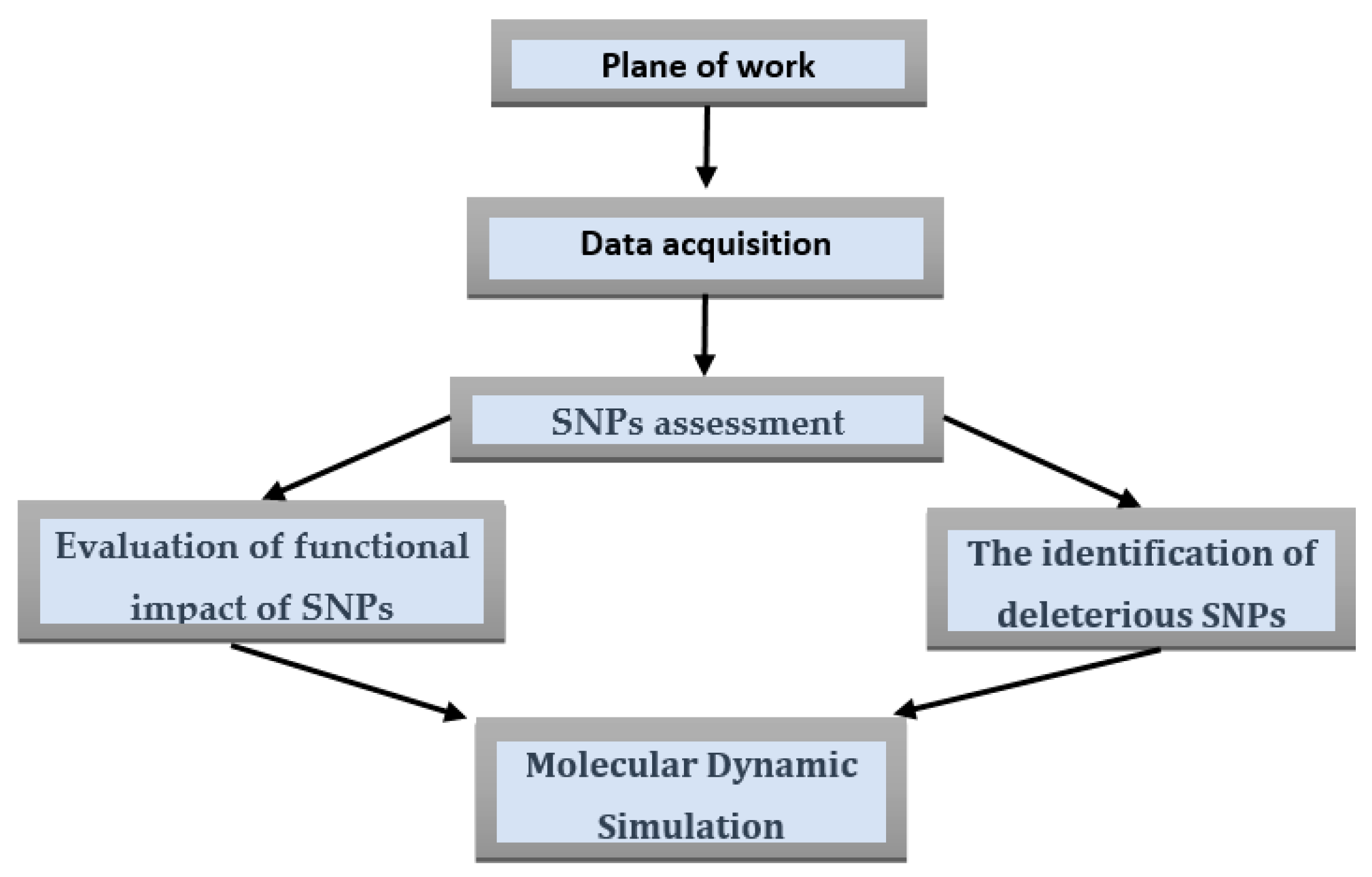
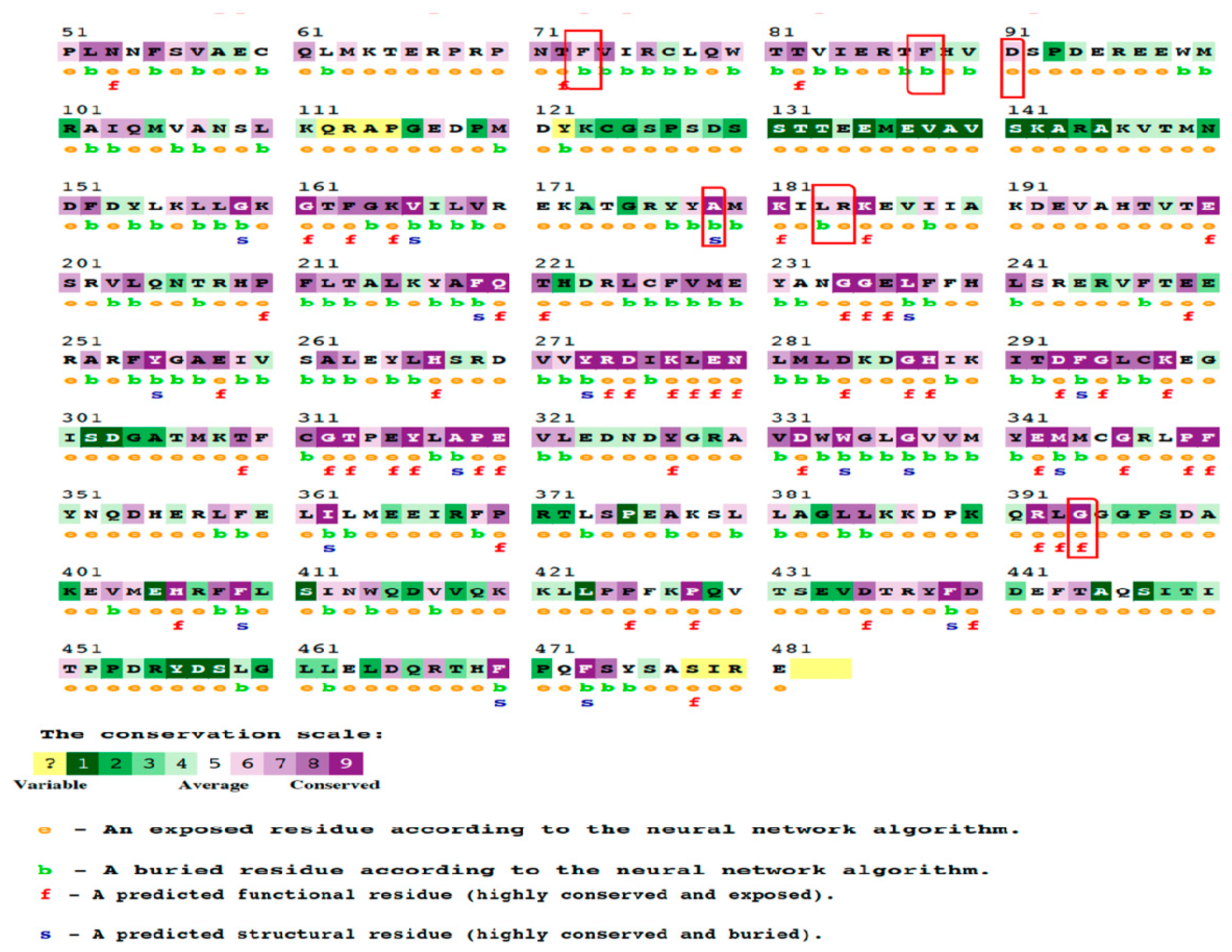
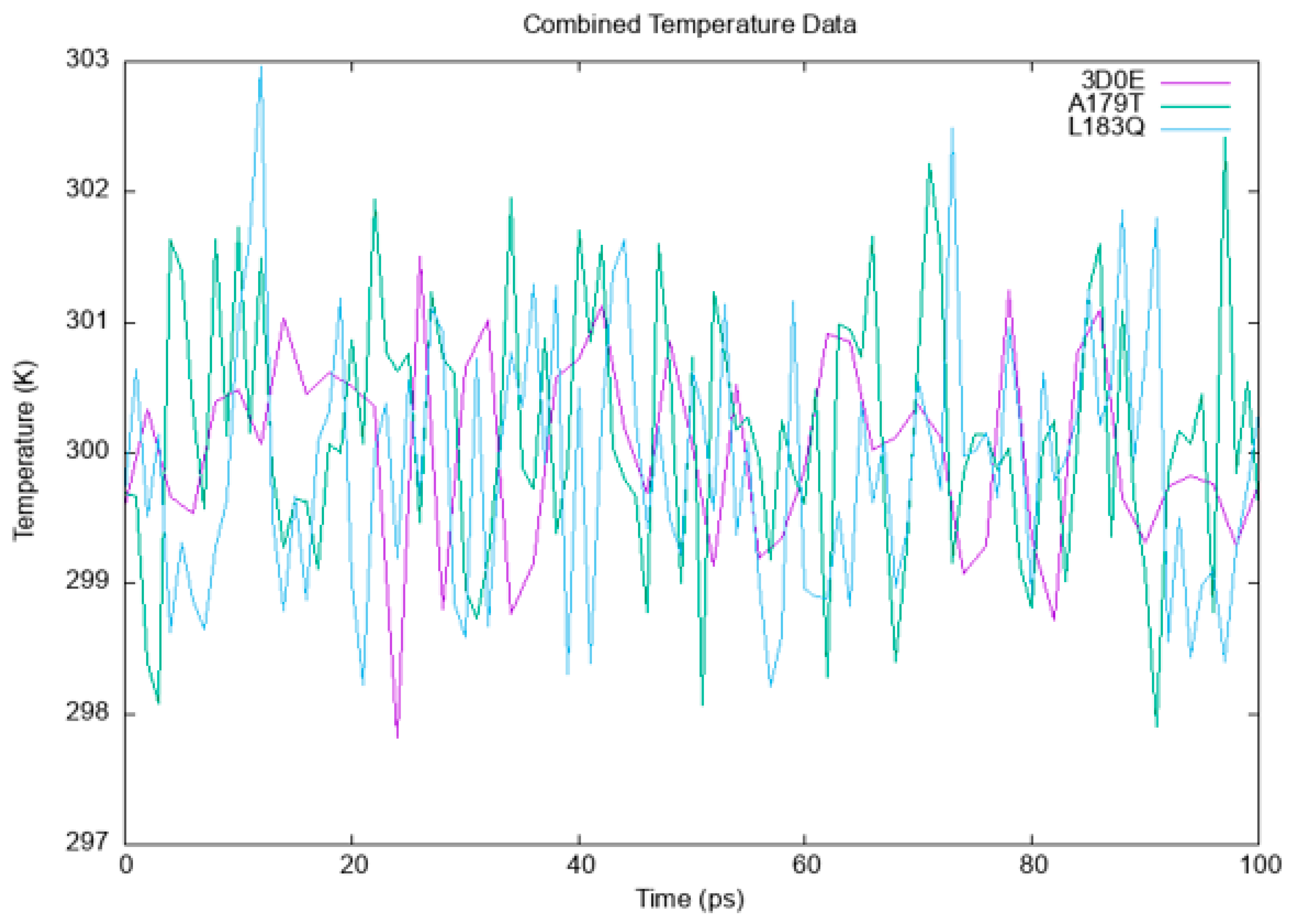
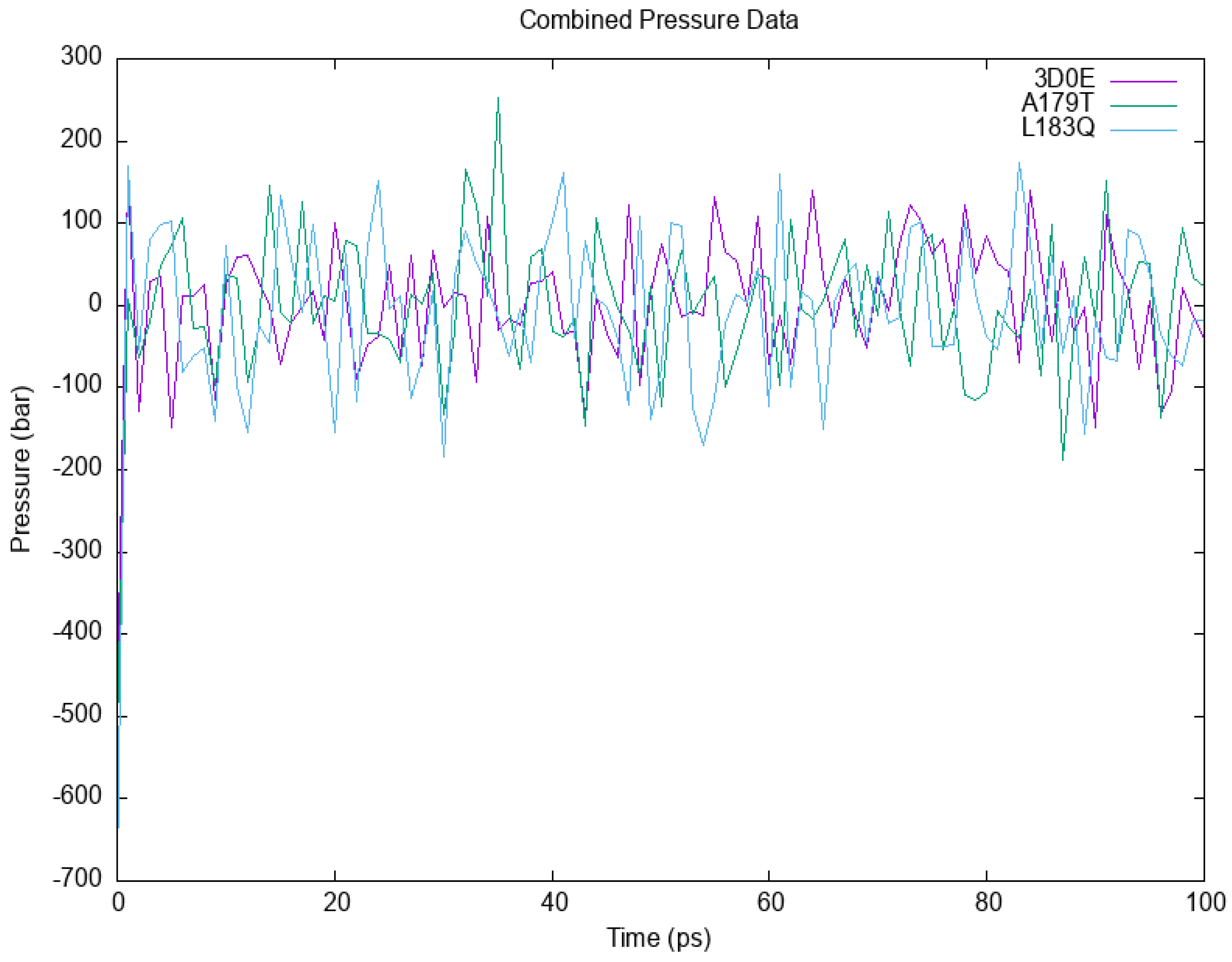
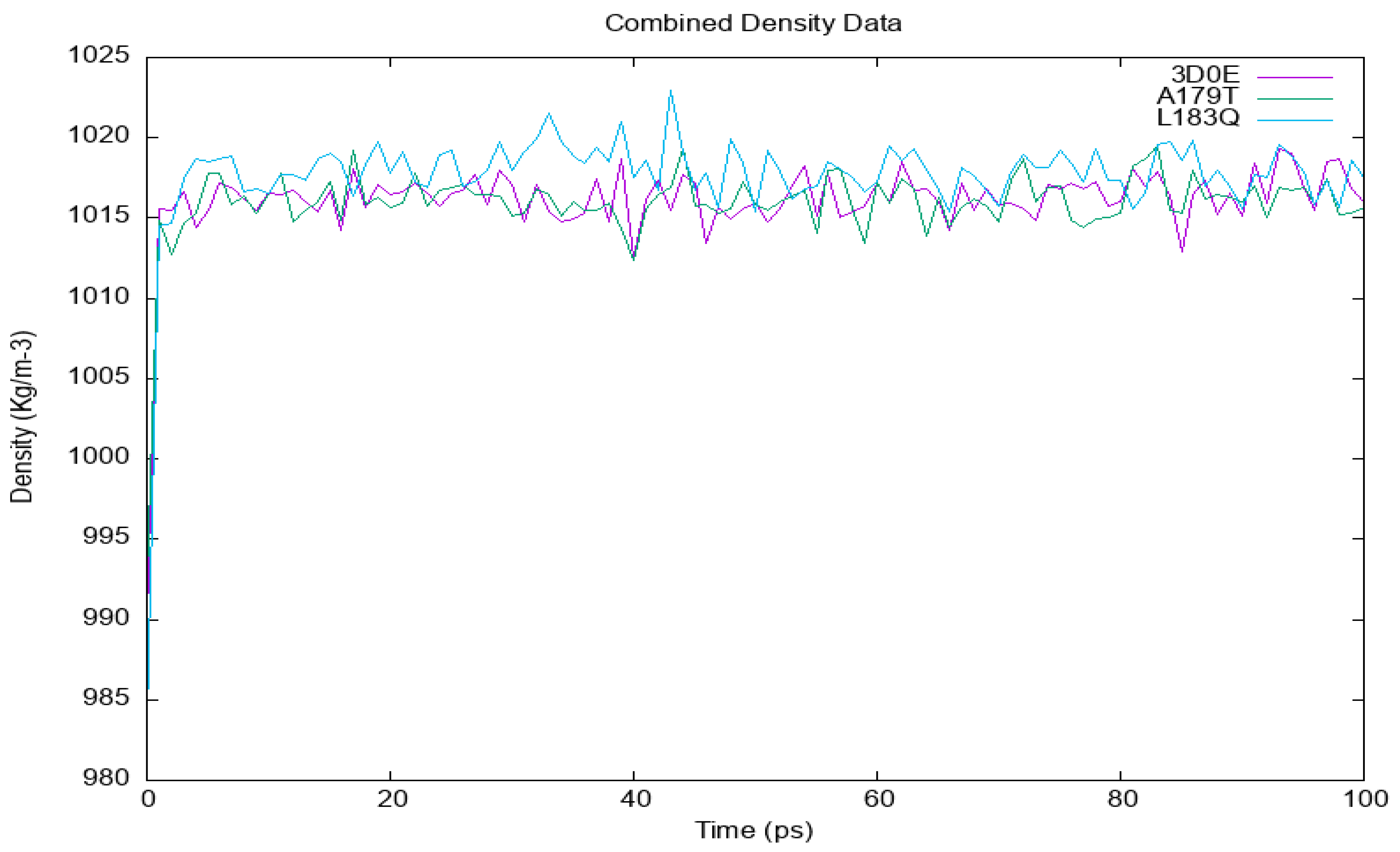
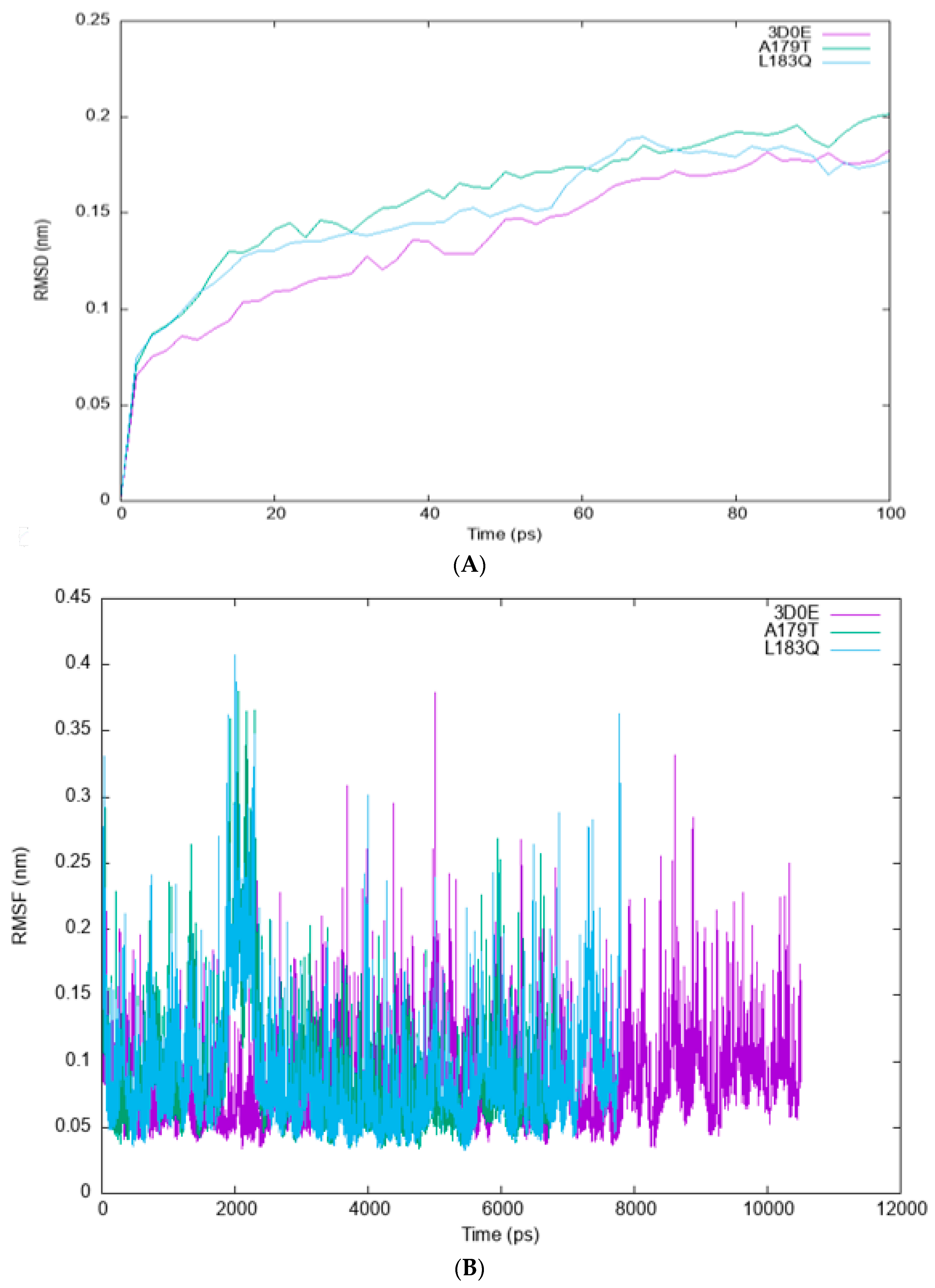

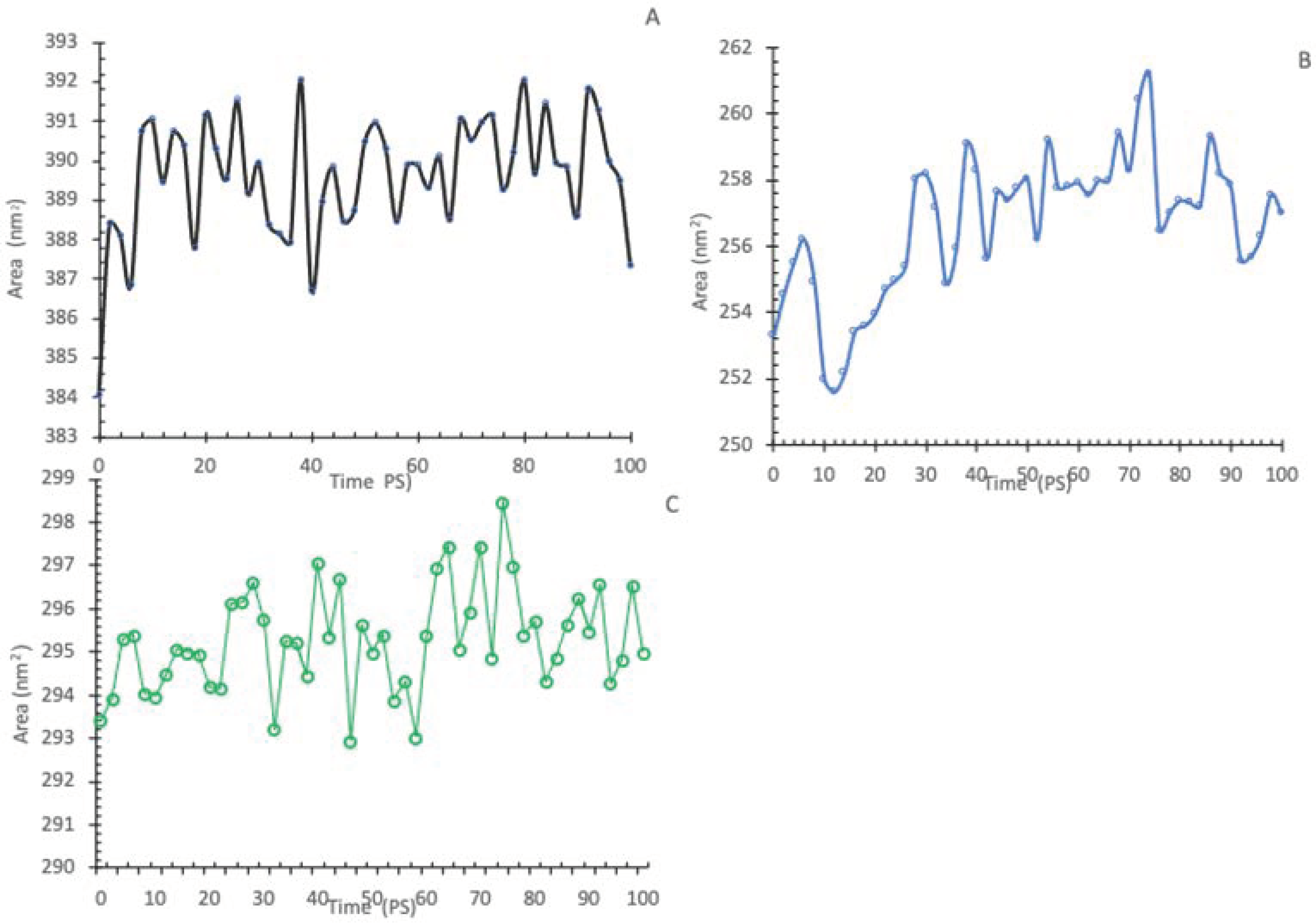

| SIFT | Polyphen | SNAP2 | PANTHER | ||||||||
|---|---|---|---|---|---|---|---|---|---|---|---|
| Variant ID | Allele | Protein | Mutation | Score | Prediction | Score | Prediction | Effects | Expected Accuracy % | pdel | Prediction |
| rs1017033490 | C|T | ENST00000311278.10 | R480H | 0.00 | deleterious | 0.988 | probably damaging | Effect | 65% | 0.57 | probably damaging |
| rs769806554 | G|A | ENST00000311278.10 | R480C | 0.00 | deleterious | 0.992 | probably damaging | Effect | 63% | 0.57 | probably damaging |
| rs769806554 | G|C | ENST00000311278.10 | R480G | 0.00 | deleterious | 0.986 | probably damaging | Effect | 75% | 0.57 | probably damaging |
| rs1447335111 | T|C | ENST00000311278.10 | Y475C | 0.00 | deleterious | 1 | probably damaging | Effect | 80% | 0.85 | probably damaging |
| rs1447335111 | T|G | ENST00000311278.10 | Y475S | 0.00 | deleterious | 0.991 | probably damaging | Effect | 91% | 0.85 | probably damaging |
| rs1368133745 | A|T | ENST00000311278.10 | F470I | 0.00 | deleterious | 1 | probably damaging | Effect | 80% | 0.85 | probably damaging |
| rs1251045508 | G|C | ENST00000311278.10 | S432C | 0.01 | deleterious | 0.999 | probably damaging | Effect | 61% | 0.85 | probably damaging |
| rs757239082 | A|G | ENST00000311278.10 | M404T | 0.09 | deleterious | 0.644 | possible damaging | Effect | 82% | 0.85 | probably damaging |
| rs757239082 | A|C | ENST00000311278.10 | V403G | 0.00 | deleterious | 1 | probably damaging | Effect | 80% | 0.57 | probably damaging |
| rs1278736092 | C|G | ENST00000311278.10 | G396R | 0.01 | deleterious | 0.999 | probably damaging | Effect | 53% | 0.86 | probably damaging |
| rs1207581157 | C|T | ENST00000311278.10 | G396R | 0.01 | deleterious | 0.999 | probably damaging | Effect | 53% | 0.86 | probably damaging |
| rs1316408057 | C|A | ENST00000311278.10 | G395W | 0.01 | deleterious | 1 | probably damaging | Effect | 66% | 0.74 | probably damaging |
| rs1371711287 | C|A | ENST00000311278.10 | G394C | 0.00 | deleterious | 1 | probably damaging | Effect | 63% | 0.89 | probably damaging |
| rs867381867 | A|T | ENST00000311278.10 | L385H | 0.00 | deleterious | 1 | probably damaging | Effect | 91% | 0.89 | probably damaging |
| rs767039609 | G|A | ENST00000311278.10 | A377V | 0.00 | deleterious | 1 | probably damaging | Effect | 63% | 0.86 | probably damaging |
| rs752215436 | G|A | ENST00000311278.10 | P370L | 0.00 | deleterious | 1 | probably damaging | Effect | 53% | 0.89 | probably damaging |
| rs754942500 | G|A | ENST00000311278.10 | R357C | 0.00 | deleterious | 1 | possible damaging | Effect | 72% | 0.57 | probably damaging |
| rs749701848 | G|A | ENST00000311278.10 | P349L | 0.00 | deleterious | 0.998 | probably damaging | Effect | 53% | 0.89 | probably damaging |
| rs1470884234 | G|A | ENST00000311278.10 | R347C | 0.01 | deleterious | 0.985 | probably damaging | Effect | 85% | 0.85 | probably damaging |
| rs1198321649 | C|T | ENST00000311278.10 | G346S | 0.01 | deleterious | 1 | probably damaging | Effect | 66% | 0.89 | probably damaging |
| rs1485158704 | A|T | ENST00000311278.10 | M344K | 0.01 | deleterious | 1 | probably damaging | Effect | 71% | 0.85 | probably damaging |
| rs765026585 | G|A | ENST00000311278.10 | R329W | 0.00 | deleterious | 1 | possible damaging | Effect | 78% | 0.86 | probably damaging |
| rs765026585 | C|A | ENST00000311278.10 | D326Y | 0.03 | deleterious | 1 | probably damaging | Effect | 80% | 0.85 | probably damaging |
| rs1257580103 | G|A | ENST00000311278.10 | A318V | 0.00 | deleterious | 1 | probably damaging | Effect | 71% | 0.89 | probably damaging |
| rs1458251691 | T|C | ENST00000311278.10 | E315G | 0.00 | deleterious | 0.995 | probably damaging | Effect | 75% | 0.86 | probably damaging |
| rs1437512007 | G|A | ENST00000311278.10 | P314L | 0.00 | deleterious | 0.998 | probably damaging | Effect | 80% | 0.86 | probably damaging |
| rs753989242 | G|C | ENST00000311278.10 | P314A | 0.00 | deleterious | 1 | probably damaging | Effect | 80% | 0.86 | probably damaging |
| rs529742537 | T|C | ENST00000311278.10 | M307V | 0.02 | deleterious | 0.998 | probably damaging | Effect | 71% | 0.74 | probably damaging |
| rs200395003 | C|T | ENST00000311278.10 | D284N | 0.04 | deleterious | 0.994 | possible damaging | Effect | 53% | 0.86 | probably damaging |
| rs777146223 | C|T | ENST00000311278.10 | R274H | 0.00 | deleterious | 0.994 | probably damaging | Effect | 85% | 0.89 | probably damaging |
| rs139506765 | G|A | ENST00000311278.10 | R274C | 0.00 | deleterious | 0.999 | probably damaging | Effect | 95% | 0.89 | probably damaging |
| rs778561687 | C|T | ENST00000311278.10 | V271M | 0.00 | deleterious | 1 | probably damaging | Effect | 95% | 0.74 | probably damaging |
| rs778561687 | G|A | ENST00000311278.10 | R269W | 0.02 | deleterious | 0.948 | probably damaging | Effect | 80% | 0.57 | probably damaging |
| rs745550650 | A|T | ENST00000311278.10 | Y265N | 0.01 | deleterious | 0.985 | probably damaging | Effect | 85% | 0.86 | probably damaging |
| rs1568518681 | G|C | ENST00000311278.10 | A252G | 0.01 | deleterious | 1 | probably damaging | Effect | 85% | 0.78 | probably damaging |
| rs930976777 | G|A | ENST00000311278.10 | R251W | 0.00 | deleterious | 0.9 | probably damaging | Effect | 66% | 0.86 | probably damaging |
| rs1568518786 | G|A | ENST00000311278.10 | R245C | 0.01 | deleterious | 1 | probably damaging | Effect | 75% | 0.89 | probably damaging |
| rs753149827 | G|A | ENST00000311278.10 | R243W | 0.00 | deleterious | 0.976 | probably damaging | Effect | 82% | 0.85 | probably damaging |
| rs756750912 | T|C | ENST00000311278.10 | N233D | 0.01 | deleterious | 0.992 | probably damaging | Effect | 66% | 0.86 | probably damaging |
| rs1020231672 | A|G | ENST00000311278.10 | Y231H | 0.00 | deleterious | 0.999 | probably damaging | Effect | 63% | 0.86 | probably damaging |
| rs145305228 | T|G | ENST00000311278.10 | T221P | 0.00 | deleterious | 1 | probably damaging | Effect | 85% | 0.89 | probably damaging |
| rs1169786300 | G|C | ENST00000311278.10 | L215V | 0.00 | deleterious | 0.997 | probably damaging | Effect | 80% | 0.86 | probably damaging |
| rs372625056 | A|G | ENST00000311278.10 | L212P | 0.00 | deleterious | 0.997 | probably damaging | Effect | 71% | 0.86 | probably damaging |
| rs1166756826 | G|C | ENST00000311278.10 | P210R | 0.01 | deleterious | 1 | probably damaging | Effect | 95% | 0.89 | probably damaging |
| rs1422114933 | G|A | ENST00000311278.10 | R202W | 0.00 | deleterious | 1 | probably damaging | Effect | 71% | 0.85 | probably damaging |
| rs1004075798 | T|C | ENST00000311278.10 | T197A | 0.01 | deleterious | 0.875 | probably damaging | Effect | 85% | 0.86 | probably damaging |
| rs776561628 | G|A | ENST00000311278.10 | R184W | 0.00 | deleterious | 0.76 | possible damaging | Effect | 71% | 0.57 | probably damaging |
| rs1568519097 | A|T | ENST00000311278.10 | L183Q | 0.00 | deleterious | 0.996 | probably damaging | Effect | 71% | 0.86 | probably damaging |
| rs1323113005 | C|T | ENST00000311278.10 | A179T | 0.01 | deleterious | 0.995 | probably damaging | Effect | 66% | 0.89 | probably damaging |
| rs763266151 | T|G | ENST00000311278.10 | T174P | 0.01 | deleterious | 0.99 | probably damaging | Effect | 91% | 0.85 | probably damaging |
| rs144395843 | G|A | ENST00000311278.10 | R170W | 0.00 | deleterious | 0.994 | probably damaging | Effect | 85% | 0.57 | probably damaging |
| rs980537301 | C|T | ENST00000311278.10 | V169M | 0.01 | deleterious | 0.997 | probably damaging | Effect | 80% | 0.85 | probably damaging |
| rs140987550 | A|G | ENST00000311278.10 | M149T | 0.02 | deleterious | 0.907 | probably damaging | Effect | 71% | 0.74 | probably damaging |
| rs762379584 | G|A | ENST00000311278.10 | S126F | 0.00 | deleterious | 0.99 | probably damaging | Effect | 66% | 0.74 | probably damaging |
| rs121434593 | A|G | ENST00000311278.10 | I103T | 0.02 | deleterious | 0.823 | probably damaging | Effect | 59% | 0.85 | probably damaging |
| rs774959037 | T|A | ENST00000311278.10 | I103F | 0.02 | deleterious | 0.999 | probably damaging | Effect | 66% | 0.85 | probably damaging |
| rs1304063423 | C|A | ENST00000311278.10 | R101W | 0.02 | deleterious | 0.913 | probably damaging | Effect | 59% | 0.5 | possibly damaging |
| rs1347953319 | C|T | ENST00000311278.10 | E97G | 0.02 | deleterious | 0.99 | probably damaging | Effect | 71% | 0.85 | probably damaging |
| rs757245351 | C/A | ENST00000311278.10 | D91Y | 0.00 | deleterious | 0.732 | possible damaging | Effect | 66% | 0.74 | probably damaging |
| rs758367800 | A/G | ENST00000311278.10 | F88L | 0.01 | deleterious | 0.999 | probably damaging | Effect | 66% | 0.86 | probably damaging |
| rs747207035 | C/T | ENST00000311278.10 | E85K | 0.02 | deleterious | 0.945 | probably damaging | Effect | 66% | 0.86 | probably damaging |
| rs1207387979 | C/A/T | ENST00000311278.10 | V74F | 0.04 | deleterious | 1 | probably damaging | Effect | 59% | 0.5 | possibly damaging |
| rs145907048 | A/C | ENST00000311278.10 | F73V | 0.00 | deleterious | 0.93 | probably damaging | Effect | 75% | 0.85 | probably damaging |
| rs1428621686 | G/A | ENST00000311278.10 | P68L | 0.01 | deleterious | 1 | probably damaging | Effect | 53% | 0.85 | probably damaging |
| rs773553776 | G/A/C | ENST00000311278.10 | P51R | 0.03 | deleterious | 0.825 | probably damaging | Effect | 75% | 0.85 | probably damaging |
| rs771461640 | G/C | ENST00000311278.10 | P51A | 0.03 | deleterious | 0.999 | probably damaging | Effect | 63% | 0.85 | probably damaging |
| rs1367814764 | T/G | ENST00000311278.10 | Y26S | 0.00 | deleterious | 0.791 | possible damaging | Effect | 91% | 0.85 | probably damaging |
| rs775105991 | C/T | ENST00000311278.10 | R25Q | 0.00 | deleterious | 1 | probably damaging | Effect | 91% | 0.86 | probably damaging |
| rs1363221582 | A/G | ENST00000311278.10 | I19T | 0.00 | deleterious | 0.987 | probably damaging | Effect | 80% | 0.86 | probably damaging |
| rs763896696 | C/A/T | ENST00000311278.10 | E17K | 0.05 | deleterious | 1 | probably damaging | Effect | 85% | 0.86 | probably damaging |
| rs988297708 | G/A | ENST00000311278.10 | R15C | 0.00 | deleterious | 1 | probably damaging | Effect | 80% | 0.86 | probably damaging |
| rs1227145174 | T/G | ENST00000311278.10 | K14T | 0.00 | deleterious | 1 | probably damaging | Effect | 91% | 0.86 | probably damaging |
| rs754286414 | C/T | ENST00000311278.10 | E9K | 0.00 | deleterious | 0.998 | probably damaging | Effect | 91% | 0.85 | probably damaging |
| rs1373751808 | T/A/C | ENST00000311278.10 | I7F | 0.02 | deleterious | 0.93 | probably damaging | Effect | 71% | 0.27 | probably benign |
| rs746407532 | C/A | ENST00000311278.10 | V6F | 0.01 | deleterious | 0.752 | possible damaging | Effect | 66% | 0.57 | probably damaging |
| PhD-SNP | SNP&GO | |||||
|---|---|---|---|---|---|---|
| Variant ID | Allele | Mutation | Score | Prediction | Score | Prediction |
| rs1447335111 | T|C | Y475C | 3 | Disease | 1 | Disease |
| rs1447335111 | T|G | Y475S | 6 | Disease | 2 | Disease |
| rs1368133745 | A|T | F470I | 8 | Disease | 5 | Disease |
| rs1371711287 | C|A | G394C | 4 | Disease | 4 | Disease |
| rs749701848 | G/A | P349L | 4 | Disease | 6 | Disease |
| rs1198321649 | C/T | G346S | 0 | Disease | 7 | Disease |
| rs1485158704 | A/T | M344K | 9 | Disease | 8 | Disease |
| rs765026585 | C/A | D326Y | 4 | Disease | 5 | Disease |
| rs1257580103 | G/A | A318V | 7 | Disease | 6 | Disease |
| rs930976777 | G/A | R251W | 2 | Disease | 5 | Disease |
| rs753149827 | G/A | R243W | 2 | Disease | 2 | Disease |
| rs145305228 | T/G | T221P | 5 | Disease | 3 | Disease |
| rs1166756826 | G/C | P210R | 4 | Disease | 6 | Disease |
| rs1422114933 | G/A | R202W | 1 | Disease | 3 | Disease |
| rs1568519097 | A/T | L183Q | 0 | Disease | 4 | Disease |
| rs1323113005 | C/T | A179T | 2 | Disease | 7 | Disease |
| rs763266151 | T/G | T174P | 7 | Disease | 4 | Disease |
| rs758367800 | A/G | F88L | 8 | Disease | 1 | Disease |
| rs145907048 | A/C | F73V | 2 | Disease | 4 | Disease |
| rs775105991 | C/T | R25Q | 7 | Disease | 3 | Disease |
| Variant ID | Allele | Mutation | I-Mutant | MUpro |
|---|---|---|---|---|
| rs1447335111 | T|C | Y475C | Decrease | Decrease |
| rs1447335111 | T|G | Y475S | Decrease | Decrease |
| rs1368133745 | A|T | F470I | Decrease | Decrease |
| rs1371711287 | C|A | G394C | Decrease | Decrease |
| rs749701848 | G/A | P349L | Decrease | Decrease |
| rs1198321649 | C|T | G346S | Decrease | Decrease |
| rs1485158704 | A|T | M344K | Decrease | Decrease |
| rs765026585 | C|A | D326Y | Decrease | Decrease |
| rs1257580103 | G|A | A318V | Decrease | Increase |
| rs930976777 | G|A | R251W | Decrease | Decrease |
| rs753149827 | G|A | R243W | Decrease | Decrease |
| rs145305228 | T|G | T221P | Decrease | Decrease |
| rs1166756826 | G|C | P210R | Decrease | Increase |
| rs1422114933 | G|A | R202W | Decrease | Increase |
| rs1568519097 | A|T | L183Q | Decrease | Decrease |
| rs1323113005 | C|T | A179T | Decrease | Decrease |
| rs763266151 | T|G | T174P | Decrease | Decrease |
| rs758367800 | A|G | F88L | Decrease | Decrease |
| rs145907048 | A|C | F73V | Decrease | Decrease |
| rs775105991 | C|T | R25Q | Decrease | Decrease |
| Mut-Pred | |||||
|---|---|---|---|---|---|
| Variant ID | Allele | Mutation | Score | Effects | Function Affected |
| rs1447335111 | T|C | Y475C | 0.9 | (−) | Loss of Relative solvent accessibility |
| rs1371711287 | C|A | G394C | 0.9 | (−) | Loss of Intrinsic disorder; Loss of B-factor; Loss of Methylation at K390 |
| rs765026585 | C|A | D326Y | 0.9 | (−) | Loss of Relative solvent accessibility |
| rs930976777 | G|A | R251W | 0.8 | (−) | Loss of Helix; Loss of Allosteric site at Y255 |
| rs1422114933 | G|A | R202W | 0.6 | (−) | Loss of Helix |
| rs1568519097 | A|T | L183Q | 0.9 | (−) | Loss of Acetylation at K181 |
| rs1323113005 | C|T | A179T | 0.9 | (−) | Loss of Helix |
| rs763266151 | T|G | T174P | 0.8 | (−) | Loss of Strand |
| rs758367800 | A|G | F88L | 0.8 | (−) | Loss of Strand |
| rs145907048 | A|C | F73V | 0.9 | (−) | Loss of Strand |
| Functional Consequence | Disease Association | Phylogenetics | Protein Stability | Function | |||||||
|---|---|---|---|---|---|---|---|---|---|---|---|
| nsSNP | Mutation | SIFT | Polyphen | SNAP2 | PANTHER | SNP&GO | PhD-SNP | ConSurf | I-Mut | MUpro | Mut-Pred |
| rs1447335111 | Y475C | * | * | * | * | ** | ** | 5, b, average | *** | *** | − |
| rs1447335111 | Y475S | * | * | * | * | ** | ** | 4, b, average | *** | *** | + |
| rs1368133745 | F470I | * | * | * | * | ** | ** | 9, b,s, conserved | *** | *** | + |
| rs1371711287 | G394C | * | * | * | * | ** | ** | 9, e,f, conserved | *** | *** | − |
| rs749701848 | P349L | * | * | * | * | ** | ** | 9, e,f, conserved | *** | *** | + |
| rs1198321649 | G346S | * | * | * | * | ** | ** | 9, e,f, conserved | *** | *** | + |
| rs1485158704 | M344K | * | * | * | * | ** | ** | 7, b, conserved | *** | *** | + |
| rs765026585 | D326Y | * | * | * | * | ** | ** | 4, e, average | *** | *** | − |
| rs1257580103 | A318V | * | * | * | * | ** | ** | 9, b,s, conserved | *** | Increase | + |
| rs930976777 | R251W | * | * | * | * | ** | ** | 5, e, average | *** | *** | − |
| rs753149827 | R243W | * | * | * | * | ** | ** | 5, e, average | *** | *** | + |
| rs145305228 | T221P | * | * | * | * | ** | ** | 9, e,f, conserved | *** | *** | + |
| rs1166756826 | P210R | * | * | * | * | ** | ** | 9, e,f, conserved | *** | Increase | + |
| rs1422114933 | R202W | * | * | * | * | ** | ** | 5, e, average | *** | Increase | − |
| rs1568519097 | L183Q | * | * | * | * | ** | ** | 6, b, conserved | *** | *** | − |
| rs1323113005 | A179T | * | * | * | * | ** | ** | 9, b,s, conserved | *** | *** | − |
| rs763266151 | T174P | * | * | * | * | ** | ** | 5, e, average | *** | *** | − |
| rs758367800 | F88L | * | * | * | * | ** | ** | 7, b, conserved | *** | *** | − |
| rs145907048 | F73V | * | * | * | * | ** | ** | 6, b, conserved | *** | *** | − |
| rs775105991 | R25Q | * | * | * | * | ** | ** | 8, b,f, conserved | *** | *** | + |
Disclaimer/Publisher’s Note: The statements, opinions and data contained in all publications are solely those of the individual author(s) and contributor(s) and not of MDPI and/or the editor(s). MDPI and/or the editor(s) disclaim responsibility for any injury to people or property resulting from any ideas, methods, instructions or products referred to in the content. |
© 2023 by the authors. Licensee MDPI, Basel, Switzerland. This article is an open access article distributed under the terms and conditions of the Creative Commons Attribution (CC BY) license (https://creativecommons.org/licenses/by/4.0/).
Share and Cite
Elangeeb, M.E.; Elfaki, I.; Elkhalifa, M.A.; Adam, K.M.; Alameen, A.O.; Elfadl, A.K.; Albalawi, I.A.; Almasoudi, K.S.; Almotairi, R.; Alsaedi, B.S.O.; et al. In Silico Investigation of AKT2 Gene and Protein Abnormalities Reveals Potential Association with Insulin Resistance and Type 2 Diabetes. Curr. Issues Mol. Biol. 2023, 45, 7449-7475. https://doi.org/10.3390/cimb45090471
Elangeeb ME, Elfaki I, Elkhalifa MA, Adam KM, Alameen AO, Elfadl AK, Albalawi IA, Almasoudi KS, Almotairi R, Alsaedi BSO, et al. In Silico Investigation of AKT2 Gene and Protein Abnormalities Reveals Potential Association with Insulin Resistance and Type 2 Diabetes. Current Issues in Molecular Biology. 2023; 45(9):7449-7475. https://doi.org/10.3390/cimb45090471
Chicago/Turabian StyleElangeeb, M. E., Imadeldin Elfaki, M. A. Elkhalifa, Khalid M. Adam, A. O. Alameen, Ahmed Kamaleldin Elfadl, Ibrahim Altedlawi Albalawi, Kholoud S. Almasoudi, Reema Almotairi, Basim S. O. Alsaedi, and et al. 2023. "In Silico Investigation of AKT2 Gene and Protein Abnormalities Reveals Potential Association with Insulin Resistance and Type 2 Diabetes" Current Issues in Molecular Biology 45, no. 9: 7449-7475. https://doi.org/10.3390/cimb45090471
APA StyleElangeeb, M. E., Elfaki, I., Elkhalifa, M. A., Adam, K. M., Alameen, A. O., Elfadl, A. K., Albalawi, I. A., Almasoudi, K. S., Almotairi, R., Alsaedi, B. S. O., Alhelali, M. H., Mir, M. M., Amle, D., & Mir, R. (2023). In Silico Investigation of AKT2 Gene and Protein Abnormalities Reveals Potential Association with Insulin Resistance and Type 2 Diabetes. Current Issues in Molecular Biology, 45(9), 7449-7475. https://doi.org/10.3390/cimb45090471







